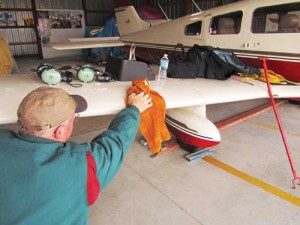by Jeffery Taylor
WisDOT Bureau of Aeronautics
At the Wisconsin Department of Transportation, we are committed to transportation safety, along with common sense efforts to enhance and preserve environmental quality. With the recent spike in fuel costs, pilots everywhere are looking for ways to reduce their aircraft fuel consumption. You may think following proper leaning practices is your only tool. However, evaluating all of your operational techniques and maintenance practices, along with careful record keeping, can significantly reduce operating costs and extend the operating range of any airplane.
The First Step – Maintenance
Aircraft Rigging – The overriding goal is to get the aircraft to fly as close as possible to the way it was designed. Regardless of the size, class or age of the aircraft you fly, it is likely a five to 10 knot airspeed loss has crept into your aircraft.
We can learn from the airlines, which over the years, have learned to carefully monitor airplane performance in an effort to maintain operational efficiency. Through detailed record keeping, airlines have found that performance of a new aircraft deteriorates at a very predictable rate as misrigging, pressurization leaks, airframe dents, and insidious weight increases contribute to drag.
Writing down true airspeed, fuel flow, fuel consumption – and other flight parameters during every flight – can tip you off to when your aircraft may be out of rig.

Airframe Drag – This is the real enemy of fuel conservation. Checking the rigging of your aircraft is an essential step in conserving fuel. On a regular basis, check passenger and cargo doors, landing gear doors, the wings, and cowl flaps for misalignment and adjust as necessary. Trim tabs should also be checked against cockpit trim position indicators to ensure accurate trim adjustments. If any one of these items is out of alignment, it will create additional drag.
Aligning mis-rigged surfaces is extremely important. If left out of alignment, you may be compensating with control inputs that can further compound the increase in drag.
Cockpit Instrumentation – In order to operate your aircraft efficiently, it is important to make sure your cockpit instruments are properly calibrated to provide accurate information. Engine instruments are among the most important. Precise settings require an accurate tachometer or manifold gauge. The exhaust gas temperature (EGT) gauge will help you lean the engine more precisely.
Airframe Cleanliness – Airframe cleanliness is often taken for granted. It is much more than a cosmetic nicety. Dirt and bugs can accumulate on the wings and act just like frost by reducing the kinetic energy of the boundary layer and increasing drag. It is a good practice, especially in the summer, to wipe down the leading edges after every flight. You will minimize drag and find that cleaning is much easier when done regularly.
Weight Reduction – Reducing the weight of your aircraft can be a quick, easy method to improve efficiency. Remember that every pound of weight requires an additional pound of lift, increasing the amount of induced drag. Go through your aircraft and refer to your Pilot Operating Handbook (POH) to decide if there is equipment or furnishings that are no longer necessary. As one pilot told me, “Pilots are like their airplanes…they get heavier with age.”
Drag Producers – Check your airplane carefully for unnecessary drag producers. After checking with the manufacturer and the FAA, are there accessories attached to your aircraft you can do without, such as steps, assist handles or doorstops? Also, if you have added new and improved avionics, take a hard look at the number and type of antennas still on your aircraft.
Proper Engine Maintenance – Drag reduction may be the most productive area in a fuel conservation program, but engine maintenance can also produce significant benefits. It is important to check spark plugs, magnetos and fuel injectors frequently. If the engine is fuel injected, make sure the injectors are within close tolerance so it can run at optimal lean settings. Otherwise, the engine can only be leaned for the one or two leanest cylinders.
The Second Step – Aircraft Operation
Preflight Planning – Good preflight planning can result in considerable fuel savings. Time invested on the ground in careful flight planning will avoid needless delays on the ramp, unnecessary fuel stops and other situations that can waste fuel and time. Spend some time with your aircraft’s POH reviewing the performance charts for your aircraft and determine its specific range, which is the aeronautical equivalent to an automobile’s miles per gallon. Dividing the miles flown by the amount of fuel used, or airspeed by the fuel flow per hour, can calculate an aircraft’s specific range. Essentially, specific range is distance traveled per unit of fuel used. If, for example, you fly 600 miles and burn 30 gallons of fuel, your specific range is 20 nautical miles per gallon.
After determining a zero-wind altitude, calculate the specific range using your estimated groundspeed. This will give you the best altitude for current conditions. The advantage of using specific range is how it relates distance to fuel used for each flight segment, be it during climb, cruise or descent.
In still air, specific range will increase slightly with altitude up to about 7,000 feet at a given power setting with a normally aspirated engine. Tailwinds improve specific range and are very inviting, but be sure to balance the groundspeed benefits of high-altitude winds against the extra time consumed in climbing to reach them.
In a headwind situation, the break-even point on wind is about one percent of the indicated airspeed (IAS) per 1,000 feet. For example, at an IAS of 100 knots, a 10-knot headwind at ground level is as much a detriment to specific range as a 15 knot headwind at 5,000 feet. In other words, you are just as well off at 5,000 feet facing a 15-knot headwind, as at ground level looking at a 10-knot headwind. That is because true airspeed tends to increase one percent per 1,000 feet, up to the maximum altitude at which that power setting can be maintained.
When choosing a cruise altitude, the total distance of the trip is a critical factor. If your climb to altitude with a normally aspirated engine will require more than 15 percent of the total enroute time, you are climbing too high. For a turbocharged engine, 25 percent is a good rule of thumb. Remember, these are general estimates. Go through the numbers for your particular aircraft, over the different stages of flight, to fine-tune your operations.
Fuel conservation begins and ends with understanding your aircraft. A thorough understanding of your POH will become a baseline from which to measure the effectiveness of your operational changes. Careful record keeping will provide you a better understanding of your fuel-saving efforts and avoid seat-of-the-pants guesses. This will require dedication and attention to detail; however, inefficient flying, and the resulting higher fuel costs, can be a real drag.
